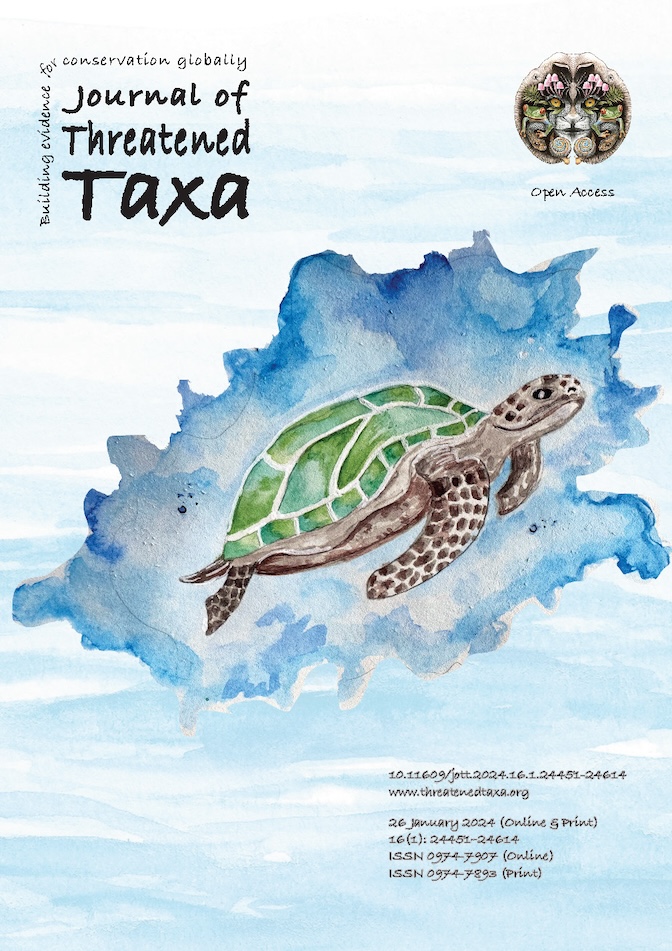Trade of skulls as novelty and aquarium objects are an additional threat to porcupines
Main Article Content
Abstract
The commercial exploitation of wildlife affects many species, including porcupines that are traded for meat, as pets, and for medicinal purposes. Here we report on a novel trade in Sunda Porcupine Hystrix javanica skulls in Bali specifically for curios and as aquarium novelty objects. Since 2018, the species is protected within Indonesia and the sale of skulls is illegal. Between December 2022 and November 2023, we visited wildlife shops in seven towns, and conducted a survey of online sellers. We recorded 44 porcupine skulls in 11 shops and 10 skulls online. Skulls sold as curios were intricately carved and were priced at USD 61, whereas skulls sold as hiding caves for aquarium fish were not carved and priced at USD 22. Porcupine skulls were sourced from Bali and Java. Especially the carved skulls are marketed primarily for international tourists and may be inadvertently taken abroad. The novel trade in skulls adds to a multitude of threats faced by porcupines, and there is a need for improved regulations and enforcement against illegal trade. Appropriate mitigation measures need to be developed to protect porcupines from unsustainable and illegal exploitation and will require the full operation of the commercial sector, local and national governments, the tourism industry and the Indonesian public.
Article Details

This work is licensed under a Creative Commons Attribution 4.0 International License.
Authors own the copyright to the articles published in JoTT. This is indicated explicitly in each publication. The authors grant permission to the publisher Wildlife Information Liaison Development (WILD) Society to publish the article in the Journal of Threatened Taxa. The authors recognize WILD as the original publisher, and to sell hard copies of the Journal and article to any buyer. JoTT is registered under the Creative Commons Attribution 4.0 International License (CC BY), which allows authors to retain copyright ownership. Under this license the authors allow anyone to download, cite, use the data, modify, reprint, copy and distribute provided the authors and source of publication are credited through appropriate citations (e.g., Son et al. (2016). Bats (Mammalia: Chiroptera) of the southeastern Truong Son Mountains, Quang Ngai Province, Vietnam. Journal of Threatened Taxa 8(7): 8953–8969. https://doi.org/10.11609/jott.2785.8.7.8953-8969). Users of the data do not require specific permission from the authors or the publisher.
Funding data
-
Royal Geographical Society
Grant numbers 123
References
Brooks, E.G., S.I. Roberton & D.J. Bell (2010). The conservation impact of commercial wildlife farming of porcupines in Vietnam. Biological Conservation 143(11): 2808–2814. https://doi.org/10.1016/j.biocon.2010.07.030 DOI: https://doi.org/10.1016/j.biocon.2010.07.030
Chavez, J., V. Nijman & I.N.A.D. Payuse (2023). Trade in sperm whale curios in Bali. Oryx 57(6): 695–696. https://doi.org/10.1017/S0030605323001047 DOI: https://doi.org/10.1017/S0030605323001047
Chavez, J., I.N.A.D. Payuse, Kuntayuni, M. Campera & V. Nijman (2024). Tourism, international wildlife trade and the (in)effectiveness of CITES. Environmental Conservation (First View): 1–7. https://doi.org/10.1017/S0376892923000292 DOI: https://doi.org/10.1017/S0376892923000292
Gomez, L. (2021). The illegal hunting and exploitation of porcupines for meat and medicine in Indonesia. Nature Conservation 43: 109–122. https://doi.org/10.3897/natureconservation.43.62750 DOI: https://doi.org/10.3897/natureconservation.43.62750
Hasan, S.M. & S. Csányi (2022). The overharvest of porcupine species for bushmeat and traditional medicine in Malaysia. Review on Agriculture and Rural Development 11(1–2): 161–167. https://doi.org/10.14232/rard.2022.1-2.161-167 DOI: https://doi.org/10.14232/rard.2022.1-2.161-167
Heinrich, S., A. Toomes & L. Gomez (2020). Valuable stones: The trade in porcupine bezoars. Global Ecology and Conservation 24: 01204. https://doi.org/10.1016/j.gecco.2020.e01204 DOI: https://doi.org/10.1016/j.gecco.2020.e01204
Hughes, A., M. Auliya, S. Altherr, B.R. Scheffers, J. Jansse, V. Nijman, C.R. Shepherd, N. D’Cruze, E. Sy & D.P. Edwards (2023). Determining the sustainability of legal wildlife trade. Journal of Environmental Management 341: 117987. https://doi.org/10.1016/j.jenvman.2023.117987 DOI: https://doi.org/10.1016/j.jenvman.2023.117987
Loke, V.P.W., T. Lim & A. Campos–Arceiz (2020). Hunting practices of the Jahai indigenous community in northern peninsular Malaysia. Global Ecology and Conservation 21: 00815. https://doi.org/10.1016/j.gecco.2019.e00815 DOI: https://doi.org/10.1016/j.gecco.2019.e00815
Mardiastuti, A., B. Masy’ud, L.N. Ginoga, H. Sastranegara & S. Sutopo (2021). Wildlife species used as traditional medicine by local people in Indonesia. Biodiversitas 22(1): 329–337. https://doi.org/10.13057/biodiv/d220140 DOI: https://doi.org/10.13057/biodiv/d220140
Mustikasari, I.A., S. Withaningsih, E.N. Megantara, T. Husodo & P. Parikesit (2019). Population and distribution of Sunda Porcupine (Hystrix javanica F.Cuvier, 1823) in designated area of Cisokan Hydropower, West Java, Indonesia. Biodiversitas 20(3): 762–769. https://doi.org/10.13057/biodiv/d200321 DOI: https://doi.org/10.13057/biodiv/d200321
Nijman, V. (2010). An overview of the international wildlife trade from Southeast Asia. Biodiversity and Conservation 19: 1101–1114. https://doi.org/10.1007/s10531-009-9758-4 DOI: https://doi.org/10.1007/s10531-009-9758-4
Nijman, V. & K.A.I. Nekaris (2014). Trade in wildlife in Bali, Indonesia, for medicinal and decorative purposes. TRAFFIC Bulletin 26: 31–36.
Nuswantoro (2023). Harusnya dilindungi, landak justru diburu gara-gara ini. Mongabay. Accessed on 12 January 2024. https://www.mongabay.co.id/2023/02/12/harusnya-dilindungi-landak-justru-diburu-gara-gara-ini/
Rao, M., T. Zaw, S. Htun & T. Myint (2011). Hunting for a living: Wildlife trade, rural livelihoods and declining wildlife in the Hkakaborazi National Park, North Myanmar. Environmental Management 48(1): 158–167. https://doi.org/10.1007/s00267-011-9662-z DOI: https://doi.org/10.1007/s00267-011-9662-z
Van Weers, D.J. (2005). A taxonomic revision of the Pleistocene Hystrix (Hystricidae, Rodentia) from Eurasia with notes on the evolution of the family. Contributions to Zoology 74(3–4): 301–312. https://doi.org/10.1163/18759866-0740304007 DOI: https://doi.org/10.1163/18759866-0740304007

